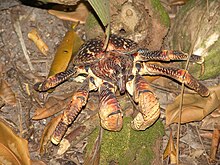Coconut crab
The coconut crab (Birgus latro) is a large edible land crab related to the hermit crab. Coconut crabs are found in the tropical parts of the Indian and Pacific Oceans. Although they are named the Coconut crab, they don't eat coconuts that often. They mainly eat fruits and nuts. Coconut crabs can climb trees. Coconut crab meat has been considered a local delicacy. Coconut crabs are extremely high priced in the national food market. They can live up to 120 years.[2]
| Coconut crab Temporal range: Neogene–present,
| |
|---|---|

| |
| Scientific classification | |
| Domain: | Eukaryota |
| Kingdom: | Animalia |
| Phylum: | Arthropoda |
| Class: | Malacostraca |
| Order: | Decapoda |
| Suborder: | Pleocyemata |
| Infraorder: | Anomura |
| Family: | Coenobitidae |
| Genus: | Birgus Leach, 1816 |
| Species: | B. latro
|
| Binomial name | |
| Birgus latro | |

| |
| Coconut crabs live on most coasts in the blue area; red points are primary and yellow points secondary places of settlement | |
| Synonyms | |
Description
changeThe coconut crab is the largest terrestrial arthropod, and indeed terrestrial invertebrate, in the world.[3][4] There are different reports on its size: most sources give a body length up to 40 cm (16 in),[5] a weight up to 4.1 kg (9.0 lb), and a leg span more than 0.91 m (3.0 ft).[6] Males are generally larger than females.[7] The carapace may reach a length of 78 mm (3.1 in), and a width up to 200 mm (7.9 in).[4]
Like with other decapots, the body of the coconut crab is divided into a front section (cephalothorax), which has 10 legs, and an abdomen. The front-most pair of legs has large chelae (claws); the left claw is larger than the right.[8] The next two pairs, as with other hermit crabs, are large, powerful walking legs with pointed tips. This allows coconut crabs to climb vertical or overhanging surfaces.[9] The fourth pair of legs is smaller with tweezer-like chelae at the end: young coconut crabs use it to grip the inside of a shell or coconut husk to carry for protection, adults use this pair for walking and climbing. The last pair of legs is very small and is used by females to tend their eggs, and by the males in mating.[8] This last pair of legs is usually held inside the carapace, in the cavity containing the breathing organs. Some difference in color occurs between the animals found on different islands, ranging from orange-red to purplish blue; in most regions, blue is the predominant color, but in some places, including the Seychelles, most individuals are red.[8]
Although B. latro is a derived type of hermit crab, only the juveniles use salvaged snail shells to protect their soft abdomens, and adolescents sometimes use broken coconut shells for that purpose. Unlike other hermit crabs, the adult coconut crabs do not carry shells, but instead harden their abdominal terga by depositing chitin and chalk. Not being constrained by the physical confines of living in a shell allows this species to grow much larger than other hermit crabs in the family Coenobitidae. Like most true crabs, Blatro bends its tail underneath its body for protection.[8] The hardened abdomen protects the coconut crab and reduces water loss on land, but must be shed yearly. Adults moult annually, and dig a burrow up to 1 m (3 ft 3 in) long in which to hide while vulnerable.[9] They remain in the burrow for 3 to 16 weeks, depending on the size of the animal.[9] After shedding, 1 to 3 weeks are needed for the exoskeleton to harden, depending on the animal's size, during which time the animal's body is soft and vulnerable, and it stays hidden for protection.[10]
References
change- ↑ Cumberlidge, N. (2020). "Birgus latro". IUCN Red List of Threatened Species. 2020: e.T2811A126813586. doi:10.2305/IUCN.UK.2020-2.RLTS.T2811A126813586.en. Retrieved 19 November 2021.
- ↑ "Giant Invasive Crab Caught Walking Down the Street in Hawaii". 30 December 2014.
- ↑ Petocz, Ronald G. (1989). "Physical and biological characteristics". Conservation and Development in Irian Jaya: A strategy for rational resource utilization. Leiden, Netherlands: Brill Publishers. pp. 7–35. ISBN 978-90-04-08832-0.
- ↑ 4.0 4.1 Drew et al. (2010), p. 46
- ↑ Naskrecki, Piotr (2005). The Smaller Majority. Cambridge, Massachusetts: Belknap Press of Harvard University Press. p. 38. ISBN 978-0-674-01915-7.
- ↑ World Wildlife Fund (2001). "Maldives-Lakshadweep-Chagos Archipelago tropical moist forests (IM0125)". Terrestrial Ecoregions. National Geographic. Retrieved April 15, 2009.
- ↑ Drew et al. (2010), p. 49
- ↑ 8.0 8.1 8.2 8.3 Fletcher (1993), p. 644
- ↑ 9.0 9.1 9.2 Greenaway, Peter (2003). "Terrestrial adaptations in the Anomura (Crustacea: Decapoda)". Memoirs of Museum Victoria. 60 (1): 13–26. doi:10.24199/j.mmv.2003.60.3.
- ↑ W. J. Fletcher; I. W. Brown; D. R. Fielder; A. Obed (1991). Moulting and growth characteristics. pp. 35–60. In: Brown & Fielder (1991)
